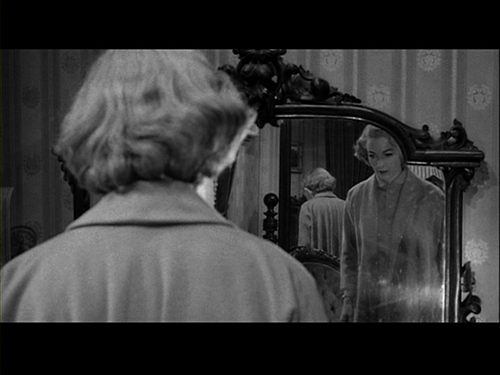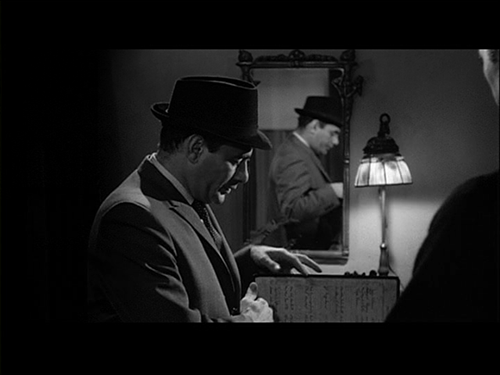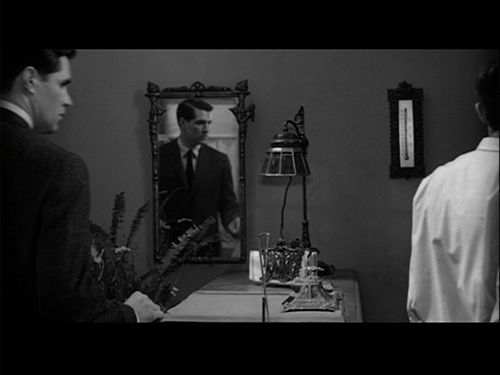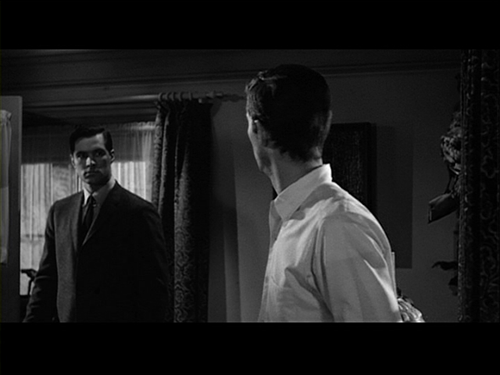Through the Looking Glass
- Swapping Loyalties
- Mirrors
Committing Crime and Exacting Punishment
- Rear Window
- Vertigo
- Psycho
Bombarding the Bombshell
Conclusion
References
Audience to Character Relations
Psycho operates in the same fashion as a metafictional novel: the production of/screening the film is the creation of the illusion we are traditionally supposed to accept at face-value, and the viewers interpretation of the films cinematic devices is the “laying bare” of the auteur’s commentaries. This relationship between audience and auteur typically translates into a relationship between character and audience in most instances, including Hitchcock films before Psycho.
Contrary to other films where we are asked to sympathize with the protagonists at the expense of identifying the storytelling structures, which facilitate such a bond, Psycho “engages the auteur’s storytelling project more directly…its dislocations affect not only the represented world but the viewer’s experience of it” (Palmer 9). This said, while a bond between the audience and character cannot be prevented, one (?) is not needed, as sympathies directed toward any one character or particular group of characters have the potential to detract from the only necessary relationships, those between one character and another.
Swapping Loyalties
Identification with the characters is also strained because of the way our loyalties are manipulated:
- Pity for Sam helps the audience side with Marion (as one is drawn to see her as the unfortunate victim of her boyfriends shortcomings), and against Lowery and Cassidy, who come off as drunken and oafish.
- As Marion flees Phoenix, the legnthy driving scene draws us into her problem. We stay focused on her face, tracing every change of emotion, hearing every fearful thought she imagines. We hope she doesnt get arrested or found out by California Charlie.
- With Norman Bates already introduced as a seemingly important character (who's innocence lures the audience into liking him), the parlor scene not only keeps the audience attune to Marion's change of heart, but also makes us wonder what will happen to sweet Norman once the "girl of his life" has left him (Truffaut 269).
- Cleaning up the bathroom and sinking Marion's car throws Norman into a villainous light, straining the beginning understanding of his character as a potential protagonist by the audience.
- Lila's introduction solicits the viewers sympathies as we realize that Marion's death truly is a loss for someone, and that Norman has just sunk the only family the film tells us that Lila has.
- Arbogasts arrival immediately puts the audience against him, his face fills the frame, invading our personal space and blocking any thoughtful interpretation of him. All one is solicited to feel is disgust.

-
Once the audience is shown that the detective has some interest in finding Marion alive (his phone call to Lila after first meeting Norman), our attitude toward him softens. Only minutes later however, he dies, and sympathies toward Norman are further strained by his diabolical glare after sinking Arbogast's car into the swamp.
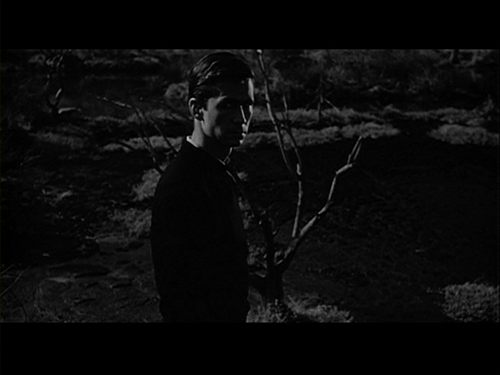
Mirrors
Just as we cannot see Norman’s gradual possession by mother, but are given a surrogate slide toward insanity, other reflections pervade the films mise-en-scene. These ‘mirrors’ function as gateways removing the audience from their understanding of one character from another, and the typical boundaries of the character-to-audience relationship.
Throughout the entire film, no principal character can avoid seeing their reflection even once. It is through the realization that Norman is a boyish reflection of Sam, that Lila is a physical reflection of Marion, and that Marionis by way of Mother a penultimate reflection of Norman that we see no one character is so different from another (Palmer 9).
Before their first physical fight, Norman turns to look back at Sam. The doorway frames Loomis in the same way a mirror would a reflection of Bates, further advancing the concept of one being the reflection of the other.
Marion is a given reflection of Norman, the literal embodiment of his statement “we all go a little crazy sometimes.” Sticking within the original text (that is, ignoring the sequels/prequels for now), we know nothing of the original Mrs. Bates, but Mother is a known homicidal force punishing the sexually expressive woman. Marion, if this is truly her fantasy rather than reality, is guilty of suicide. If one considers committing suicide in your own dream just another name for murder, Marion can be said to be that same punishing force Mother is.

